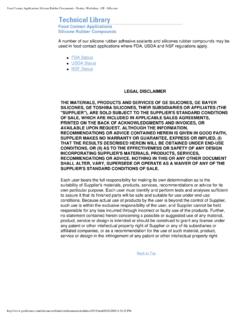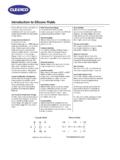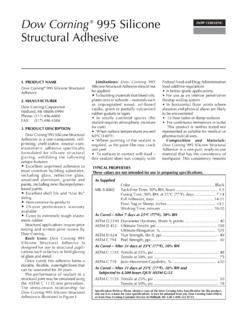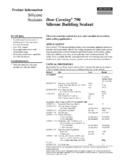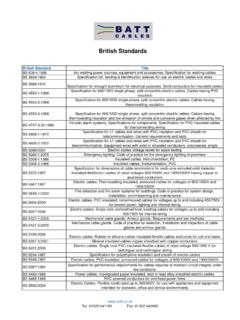Transcription of Keypads Design Guide - Comdes: componenten voor ...
1 Keypads Design Guide 2009 108th St Suite 901 Grand Prairie, TX 75050 (972) 343-9011 (800) 654-3662 (972) 606-1114 - Fax Actuation Force: The force required to collapse the membrane of a rubber switch (identified as F1 on the force/stroke curve). Air Channel: Air path(s) on the bottom of rubber Keypads and switches that allows for air passage (venting) when switch is actuated. Switches must be vented on a least two sides. Alignment Hole: Through hole in rubber keypad that is used to position keypad in enclosure when overall keypad size exceeds three inches in either length or width. Base: silicone sheet material that joins all keys/switches on a rubber keypad.
2 Also known as apron. Bezel: The faceplate or cover, typically either plastic or metal, used to secure a key pad to a printed circuit board. The bezel also aligns the keypad during the final assembly and protects keypad-base material from contact with human hands. Breakdown Voltage: Voltage at which an insulator or dielectric ruptures. Also know as dielectric strength. Compression Set: The measurement of a material's ability to recover its original size and shape after compression under prescribed conditions. It is usually expressed as a recover percentage (fraction) of the compression condition. Conductive rubber Switch: Mechanical switch made of silicone rubber , either direct or indirect contact.
3 Contact: The current-carrying area/surface under each rubber switch (conductive pill or carbon-inked surface) that makes electrical connection with the electrode on a printed circuit board when the switch is actuated. Contact Force: The force required to maintain rubber -switch contact closure (F2) force/stroke curve) with a printed circuit board. Contact Rating: The electric power handling capability for rubber contacts under strictly controlled laboratory conditions. Contact Resistance: silicone - rubber Keypads manufactured using a two-shot molding process and two-material hardnesses. Dual Durometer: silicone - rubber Keypads manufactured using a two-shot molding process and two-material hardnesses.
4 Electrode: Contact surface/ Design on a printed circuit board that conducts current when rubber switch is actuated and switch closure occurs. Key Height: The measured distance from the bottom of a keypad (base) to the top surface of a key. Legend: Some type of printed graphic (symbol, letter or number) on the top of the key surface. Life: The number of switch actuations realized before the switch membrane ruptures or over stresses. Membrane: The non-conductive hinge that permits a rubber key to flex, and is responsible for the tactile feel realized. Negative-Image Graphics: Graphics that allow switch color or switch masking color to be seen through top-surface printing on keypad.
5 Overstroke: Additional travel experienced with a rubber switch after initial switch closure has been realized. rubber switches with overstroke require a double-cone or double-bell shaped membrane. Positive-Image Graphics: Single or multi-color printing on top of key surface. Return Force: Force created by switch membrane as it returns the key to a non-actuated position. Snap Ratio: (F1-F2) divided by F1. The difference between the actuation force (F1) and the contact force (F2) of a switch divided by the actuation force. Stroke: Distance from the contact surface on a rubber switch to an electrode pattern on a printed circuit board.
6 Materials / Manufacturing silicone rubber Features: silicone rubber is a synthetic rubber compound that possessed the most desirable properties of both organic and inorganic materials. It has a manmade chain of siloxane linkages Si-O as detailed below. Characteristics: The data in the table below is representative of standard performance material used in the manufacture of conductive rubber Keypads . Contact ARC for more information on high performance material if your application required higher grade material than what is listed. Physical, Mechanical and Electrical Characteristics of silicone Physical Characteristics Conductor Insulator carbon pill silicone UL Flammability Rating 94HB Specific Gravity at 25C - - - - - - - - 1 - Durometer (Shore A) - - - - - - - - - 65 +/- 5 40 - 80 +/- 5 Tensile Strength (Kg/cm2)
7 - - - - - - 70 55 - 75 Compression Set %* - - - - - - - - - 20 11 - 22 Insulation Breakdown 26k v/mm Volume Resistivity - - - - - - - - - - - 5 3x10 to 14th power - 10 to 15th power Mechanical Characteristics Key Stroke - mm Actuation Force 20 - 350 grams Operating Life 1 million actuations (typical) Operating Temperature -30 - +180 C** Storage Temperature -42 - +250 C** Electrical Characteristics Contact Resistance <200 ohms** Insulation Resistance @ 500 VDC >100 Mohms Contact Bounce <12 msec Contact Rating 30 mA @ 12V DC .5 sec. Dielectric Strength >1 min. @ 500V RMS * After 22 hours at 175 C ** To convert degrees Fahrenheit to degrees Centigrade use formula: ( F-32) divided by ** Based on gold or nickel-plated printed circuit board Manufacturing Process All of ARC s conductive rubber Keypads and switches are compression-molded in precise carbon steel tools using highly elastic, non-toxic silicone rubber compounds.
8 After molding, all Keypads are subjected to a two-hour post-curing cycle at a temperature of 200 C. Post curing is essential to the manufacturing process because it removes catalyst and oxidant residue retained by the keypad during the molding process, stabilizes the physical properties of the silicone and increases thermal stability. Please click here to see our Manufacturing/QC page for further information. Dimensional Tolerances Great care should be exercised when a keypad is designed using silicone rubber because it is a highly elastic material subject to manufacturing variations. Tolerances for silicone rubber , by nature, need to be considerably larger than those for less-elastic materials because silicone tolerances are affected by variances in shrink rates, molding conditions and material compounds.
9 silicone rubber Dimensional Tolerance* Dimension (mm) Tolerance (+/-) - mm - mm - mm - mm - mm - mm and up * Contact ARC to determine if more precise tolerances are available for your Design . PC Plastic Dimensional Tolerance* Dimension (mm) Tolerance (+/-) - mm - mm - mm Actuation Force Tolerances The membrane shape and size of all rubber switches can be designed so that almost any actuation force and tactile feel can be realized. Most applications require positive tactile feel with relatively long life, so an actuation force of approximately 125 - 150 grams is typically recommended with an accompanying snap ratio of approximately 40 - 60%.
10 Actuation Force Tolerances** Design Force (grams) Tolerance (+/-) 50 15 g 75 20 g 100 25 g 125 30 g 150 35 g 175
